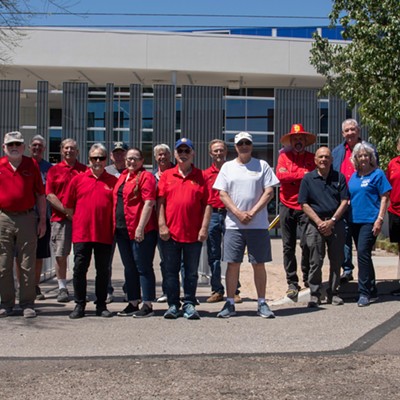Brush Wellman, which produces a deadly form of beryllium oxide as part of its manufacturing process, was the first stop on a "Toxic Tour of Tucson" sponsored by Families Against Cancer and Toxics (FACT) and the Environmental Justice Action Group (EJAG).
The visit to Brush focused on the smokestack, which the tour guide said releases tiny particles of beryllium. This facility manufactures products based on beryllium oxide, a product with unique heat and thermal properties used in a variety of applications ranging from medical to military uses, according to the Brush Web site.
"It's not really a smokestack; it's really the rear end of a vacuum cleaner," said Brian Blank, a geologist and member of EJAG. "And the wind blows 80 percent of the time to the northwest, where the schools are."
Six Sunnyside schools are located within three miles of the Brush plant.
Blank reckoned that roughly 15 percent of the population develops sensitivity to beryllium, which attacks the lungs in a similar way that smoking causes lung cancer. It has been documented that exposure to beryllium can cause chronic beryllium disease (CBD), or beryliosis, which takes 10 to 15 years to develop after as little as a month or as long as 30 years of exposure to beryllium.
While Brush Ceramics officials claim that the area surrounding their plant is completely safe, a number of employees at the plant have gotten sick with the disease. While the company has taken measures to better protect employees, at least one former Brush worker has died: Rosa Maldonado, in 2003. (See "Passing On," Currents, May 22, 2003, and "Something in the Air," Feb. 13, 2003.)
Blank said community leaders allow Brush to remain in business because beryllium is used for nuclear bombs.
"Do you want bombs, or do you want cleaner air?" Blank asked. "It's legal for them to poison us thanks to the government's lax standards."
John Scheatzle, general manager of Brush Ceramic Products, declined to comment on Blank's assertions.
"The only thing I will say is that our emissions are consistently far, far below the EPA standard, and the EPA standard has been shown to be a very effective standard for over 50 years," Scheatzle said.
Robert Bullard, a sociology professor at Clark Atlanta University who joined the tour, called the Brush Wellman plant a typical violation of environmental justice, the principle that all communities have the right to equal protection of environmental laws and that no community should have a concentration of environmental hazards. Bullard is often called the "father of environmental justice," because he began speaking out on the issue after noticing that landfills and environmentally hazardous businesses are often dumped into poor and minority neighborhoods. The poorer communities are often left behind by the government and authorities in times of emergencies and disasters.
"It's not a Southern thing; it's not a black thing--everyone can face this," Bullard explained at a lecture given at the University of Arizona the previous night.
The government often fails to respond to specific communities if they are not of the white, affluent variety, Bullard said. He said "fence-line communities"--those on the edge of industrial areas--are often neglected.
"We're not going to allow the government to sit on their hands and allow us to die," said Bullard. "A fence-line community has never attacked a plant, but a plant has been known to attack a fence-line community."
Bullard touched on an environmental injustice incident in Warren County, N.C., in 1982, when more than 500 demonstrators were arrested for protesting the establishment of the hazardous PCB landfill, which the government took 21 years to clean up. He also cited a recent train wreck in Aiken County, S.C., where a plume of chlorine was created. The white community was evacuated immediately, but the black community wasn't instructed to leave for 13 hours, said Bullard.
Bullard also pointed out the government's miserable response to Hurricane Katrina.
"It's incompetence on top of incompetence on top of incompetence," he said. "Katrina is going to be the mother of all toxic cleanups."
Bullard's talk was part of an annual guest lecture series for the Southern Arizona Geographers' Association, the professional society of graduate students in geography at the UA.
Brian Marks, a first-year graduate student in geography, chose Bullard to speak because he has a wide appeal to those involved in the social and natural sciences. Bullard's grasp of environmental issues in correlation with social problems facing the United States make his discussion of toxic-waste dumps and landfills all the more significant, said Marks.
Back on the tour, as the bus made its way to a southside aquifer that had been contaminated with TCE and designated a Superfund site, Bullard said that the environmental justice movement has come a long way and has made connections throughout America. But he foresaw many fights ahead.
"This is a marathon; it's not a sprint," he said. "This is a long-term struggle, and you have to be in it for the long haul."












